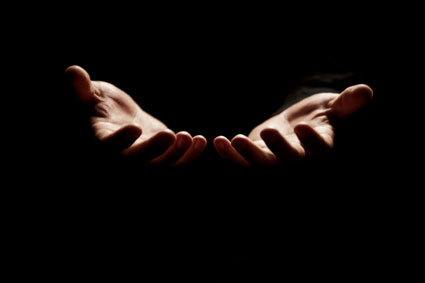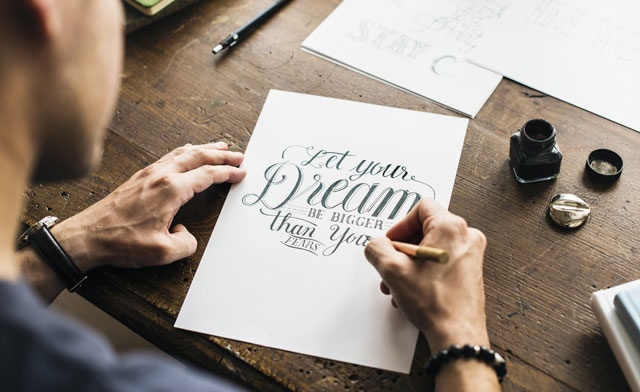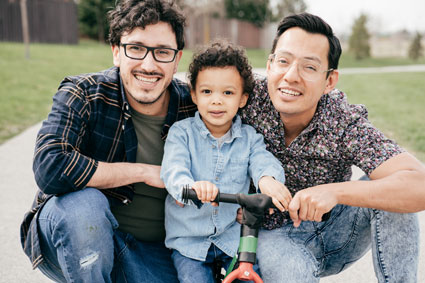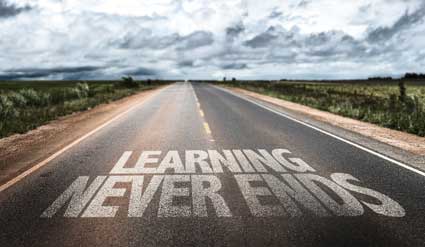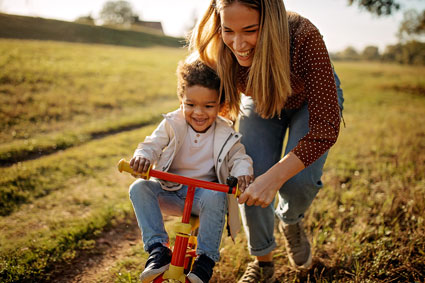Introduction
Language and literacy development are major domains of early childhood development. They involve development of the skills used to communicate with others through languages (language development), as well as the ability to read and write (literacy development). An example of language and literacy development in childhood learning is to speak the native language of one's parents and read basic words in that language. This type of development begins from birth, even though babies are not yet able to speak using language. The following article covers the key areas of knowledge one should have in regard to early childhood language and literacy development, including key concepts, ways that adult caregivers can support the language and literacy development of babies and young children, and common communication disorders.
Key Concepts
Language has been defined as "a system of symbols that is used to communicate." 2 Related to this, bilingualism is the ability to speak at least two languages. Children are born with the brain capacity to learn language because it is an innate feature of the human brain. The brain regions responsible for language development are Broca's area, which controls speech production, and Wernicke's area, which controls the understanding and cognitive processing of language2.
Language develops through children's interactions with other people around them. For example, a baby hears his or her mother talk directly to him or her, as well as to other people. Hearing the mother's speech may encourage a baby to try to imitate the sounds that he or she hears over time. Furthermore, the baby will quickly learn which words are connected to certain objects or people, and which words may produce particular responses from others.
Literacy is defined as the ability to read and write1. Like language, literacy develops through the interactions a child experiences with others. In early childhood, for example, literacy can develop through hearing stories read from books and showing children pictures with words. It is important that adults do not attempt to force adult levels of reading onto children in their early development, as this is considered developmentally-inappropriate and may actually work against healthy development1. For example, a child who is pushed to learn to write too soon may come to connect the activity of writing with failure and disappointment.
Ways to Support Language and Literacy Development in Early Childhood
There are simple ways that adult caregivers can help support the language and literacy development within early childhood. One way to do this is through books. The following tips help support children's healthy development in this area using books1:
- Incorporate books and reading into daily routines, like a part of a child's bedtime ritual.
- Remember that very young children may not have the attention span to sit through long books; reading a book partially is still helpful.
- Use all forms of verbal expression to read to children, including reading, singing, and conversing about the content of books.
- Connect the stories found in books to the child's life (i.e., personalize them).
- As babies get older, show them the words that you are reading, as you read them.
- Keep children engaged in reading by asking them questions along the way, or letting them tell stories.
- Keep in mind that what young children like in books is different than what older children like; for example, books with bright colors, large print, and lots of novelty are more appealing to young children.
Communication Disorders
For some children, language development does not occur in a typical fashion and a communication disorder may emerge. Such disorders are characterized by deficits in children's skills in speaking, listening, and/or communicating with others2. Common communication disorders include2:
- Expressive language disorder – involves incorrect use of words and tenses, problems forming sentences (which are typical of the child's age), and limited vocabulary
- Phonological disorder – involves trouble with correct sound production and selection (e.g., a child with this disorder may replace one sound for another)
- Stuttering – involves difficulty with the timing of sounds and words which impairs overall fluency; a child who stutters may frequently pause in the middle of speech or repeat the same words several times while speaking.
- Dyslexia - This is considered a learning disability and not necessarily a communication disorder, although it may affect communication; it involves difficulty with separating distinct sounds contained in words and makes reading especially difficult.
- Dysgraphia – This is considered a learning disability and not necessarily a communication disorder, although it may affect communication; it involves difficulty with writing -- problems with spelling, proper handwriting, or expression of thoughts in written form.
Conclusion
Language and literacy are major domains of early childhood development. These are connected areas, but refer to different things. Language development involves the development of the skills used to communicate with others through languages, while literacy development involves the ability to read and write. Babies are born with the capacity for development in these areas. There are simple ways that adults can support this development. In addition to understanding basic behaviors, adults should also be aware of common communication disorders, which may impede language and literacy development.
Introduction
Developmental milestones are typical changes that occur for children as they grow from birth throughout childhood. They are reached at different times for different children and may be impacted by developmental disabilities. Research has helped shed light on the developmental milestones that occur for most children within all of the major domains of development, including physical, cognitive, emotional/social, and language/literacy development. The following section presents the key milestones that babies and toddlers should reach in the first five years of life.
Milestones in Physical Development
Physical development is a major domain of early childhood development. It encompasses the biological development of the body -- such as body growth and organ development -- and skills that are performed using the body. The following chart summarizes the key milestones that are typically reached in physical development in early childhood.
|
Age |
Milestones |
|
By 2 months |
Can begin to hold head up Starts pushing up during tummy time Movements of limbs become smoother |
|
By 4 months |
Can hold head steady without support Pushes legs against hard surfaces May begin rolling over Can grasp and hold toys |
|
By 6 months |
Can roll over bi-directionally Can sit unsupported Can support own weight on legs; may also be able to bounce up and down |
|
By 9 months |
Can stand while holding onto something for support Can maneuver body into a sitting position Can crawl |
|
By 1 year |
Can walk, sometimes needing support of nearby objects Might be able to stand and/or walk without holding on |
|
By 1½ years |
Can walk without support May be able to stair climb or run Can drink from a cup Can carry objects like toys while walking Can eat with a utensil |
|
By 2 years |
More coordination (e.g., can kick or throw a ball) Can stair climb Can draw and color |
|
By 3 years |
Can easily stair climb, run, etc. Can use a bike (e.g., tricycle, bike with training wheels) |
|
By 4 years |
Can hop and stand on one foot Can catch balls with greater accuracy Can eat with more control (e.g., pouring own juice) |
|
By 5 years |
Can hop, skip, and stand on one foot for an extended time May be able to do complex movements (e.g., somersaults, climbing) Can use the toilet Can use more utensils at mealtime |
Source: Adapted from information by the Centers for Disease Control and Prevention1
Milestones in Cognitive Development
Cognitive development is a major domain of early childhood development. Cognition involves operation of the mind, or thinking. Examples of cognitive development in childhood include children learning to distinguish between behaviors that will be rewarded, versus those that will be punished by their parents, and then making decisions (e.g., to follow directions) based on this reasoning. The following chart summarizes the key milestones that are typically reached in cognitive development in early childhood.
|
Age |
Milestones Interested in learning more? Why not take an online Stages of Childhood Development course?
|
|
By 2 months |
Notices faces Can begin tracking people and objects with eyes May express boredom without novelty (e.g., crying) |
|
By 4 months |
Can express happiness and sadness Can respond to affection from others Can recognize familiar people and things |
|
By 6 months |
Can intentionally bring objects to mouth Can pass objects between both hands Expresses more curiosity about environment |
|
By 9 months |
Can look for hidden objects (may or may not find them) Can look at objects as they fall Can play "peek-a-boo" |
|
By 1 year |
Can easily find hidden objects Explores in new ways (e.g., throwing, banging on objects) Can copy other people's gestures Can follow simple directions |
|
By 1½ years |
Can understand the function of objects (e.g., phone, plate) Can point to things to express interest Can follow more directions |
|
By 2 years |
Can distinguish shapes, colors, etc. Can learn and recall the content of books and songs Can follow more complex directions |
|
By 3 years |
Can play pretend games Can understand the meaning of numbers Can solve problems (e.g., how to fit puzzle pieces or blocks together) |
|
By 4 years |
Can names colors, letters, numbers, etc. Can remember story plots Can distinguish more complex ideas (e.g., same vs. different) Can play more difficult games (e.g., board, card) |
|
By 5 years |
Can count Can draw with more complexity Can understand daily scenarios (e.g., going to school, grocery store shopping) |
Source: Adapted from information by the Centers for Disease Control and Prevention
Milestones in Emotional and Social Development
Emotional and social development are major domains of early childhood development. This type of development is critical to human functioning and rooted in the biology of human beings -- and a critical one for healthy functioning throughout life. The following chart summarizes the key milestones that are typically reached in emotional and social development in early childhood.
|
Age |
Milestones |
|
By 2 months |
Can smile at others Can self-soothe |
|
By 4 months |
Enjoys play and novelty May be able to copy facial expressions |
|
By 6 months |
Can recognize strangers vs. familiar people Can respond to the emotions of others Can recognize self in mirror |
|
By 9 months |
May become clingy to caregivers and fearful of strangers May have developed favorite toys |
|
By 1 year |
Can gain attention through sounds and actions May be fearful of new situations or the departure of a caregiver May show preference toward things or people |
|
By 1½ years |
May engage in temper tantrums Can play pretend games Can explore a lot but may need caregiver close by |
|
By 2 years |
Can copy the behavior of others Becomes more independent May disobey rules or act resistant |
|
By 3 years |
Can show affection for peers Imitates the actions of others Can show empathy Greater range of emotional expression |
|
By 4 years |
Becomes more creative Shows and expresses own interests Shows more interest in playing with others than alone |
|
By 5 years |
Shows interest in friends and in pleasing them Has gender awareness More following rules than disobeying of earlier age |
Source: Adapted from information by the Centers for Disease Control and Prevention1
Milestones in Language and Literacy Development
Language and literacy development are major domains of early childhood development. They involve development of the skills used to communicate with others through languages (language development), as well as the ability to read and write (literacy development). An example of language and literacy development in childhood is learning to speak the native language of one's parents and read basic words in that language. The following chart summarizes the key milestones that are typically reached in language and literacy development in early childhood.
|
Age |
Milestones |
|
By 2 months |
Makes cooing and gurgling sounds Pays attention to sounds |
|
By 4 months |
Can babble Will cry in various ways to express needs (e.g., hunger, tiredness) |
|
By 6 months |
Can respond to people with basic sounds Can pronounce vowels Can recognize own name |
|
By 9 months |
Can make basic sounds (e.g., "dada" and "mama") Can copy the sounds of other people |
|
By 1 year |
Can respond to others' requests Can try to verbalize the words that he or she hears Can communicate through gestures (e.g., shaking head no) |
|
By 1½ years |
Can say many words May communicate through pointing |
|
By 2 years |
Can form short sentences Can repeat more words used by others Can name objects and people |
|
By 3 years |
Can hold conversations Can names more objects and people Understands more complex instructions (2 to 3 steps) |
|
By 4 years |
Can tell stories Understands some grammatical rules Can sing a song or recite a poem |
|
By 5 years |
Can speak in clear sentences Can understand tense (e.g., past vs. future) May be able to recite more complex things (e.g., own address) |
Source: Adapted from information by the Centers for Disease Control and Prevention1





